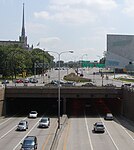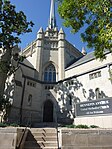Minneapolis Scottish Rite Temple

The Scottish Rite Temple, formerly the Fowler Methodist Episcopal Church, is a historic church building in the Lowry Hill neighborhood of Minneapolis, Minnesota, United States. It was designed by architects Warren H. Hayes and Harry Wild Jones. The original portion, the rear chapel, was designed by Warren H. Hayes and built in 1894. When the congregation expanded and more funds were available, Harry Wild Jones designed an addition that expanded it to a much larger structure. This was completed in 1906.The Fowler congregation merged with the Hennepin Avenue Methodist Church in 1915, and the Scottish Rite Temple bought the building the next year. They made some modifications to the auditorium to accommodate Masonic rituals, but most of the original features were kept, including extensive use of stained glass. The exterior is built of hard quartzite from southwestern Minnesota, along with red sandstone trim. It has two massive towers, three arches over the entry porch, and a 24-foot-diameter (7.3 m) rose window. The church was listed on the National Register of Historic Places in 1976.
Excerpt from the Wikipedia article Minneapolis Scottish Rite Temple (License: CC BY-SA 3.0, Authors, Images).Minneapolis Scottish Rite Temple
Dupont Avenue South, Minneapolis Bde Maka Ska - Isles
Geographical coordinates (GPS) Address Nearby Places Show on map
Geographical coordinates (GPS)
| Latitude | Longitude |
|---|---|
| N 44.9625 ° | E -93.292777777778 ° |
Address
Dupont Avenue South 2011
55405 Minneapolis, Bde Maka Ska - Isles
Minnesota, United States
Open on Google Maps








